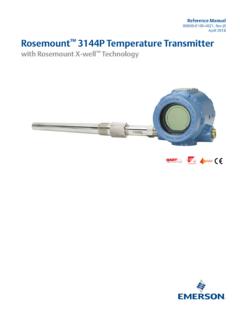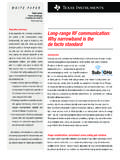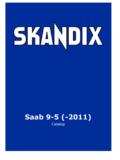Transcription of Volatilization, Evaporation & Vapor Pressure …
1 PROCEEDINGS OF THE TWENTY-EIGTH CONFERENCE OF THE NORTH AMERICAN THERMAL ANALYSISSOCIETY, OCTOBER 4-6, 2000, ORLANDO, FLORIDA216 volatilization , Evaporation & Vapor Pressure STUDIESUSING A THERMOBALANCED uncan M. PriceIPTME, Loughborough University, Loughborough, Leics. LE11 3TU, is considerable interest in performing volatilization and evaporationmeasurements by thermogravimetry. A quick and simple method for determiningvapor Pressure using a conventional thermobalance and standard sample holdershas been developed. These yield meaningful thermodynamic parameters such asthe enthalpies of sublimation and vaporization.
2 Under favorable conditions themelting temperature and enthalpy of fusion of compounds can be obtained. Thistechnique has been used for the study of dyes, UV absorbers and plasticizers. Theuse of modulated-temperature programs for such work is also The tendency of a substance to enter the Vapor phase by sublimation(solid?gas) or Evaporation (liquid?gas) is defined by its Vapor of this parameter is crucially important for a wide variety ofmaterials. Sublimation and Evaporation are zero-order processes, the rate ofmass loss of a sample under isothermal conditions due to vaporization should beconstant providing that its free surface area does not change (1).
3 Doyle reportedthis process in 1961, and considered the kinetic analysis of thermogravimetricdata with reference to the Evaporation of octacyclotetrasiloxane under drynitrogen as a model zero order process (2). Based upon earlier studies by Ashcroftand others (3-5), Price and Hawkins (6) have shown that it is possible to usethermogravimetry to determine Vapor pressures using the Langmuir equation forfree Evaporation (7):RTMptm 2dd= (1)where -dm/dt is the rate of mass loss per unit area, p the Vapor Pressure , M themolecular weight of the effusing Vapor , R is the gas constant, T the absolutetemperature and is the vaporization coefficient.
4 Normally, this type of study ispreformed in vacuo, but, by using a calibration procedure based upon measuringthe rates of weight loss of standard materials whose Vapor pressures are known,Price and Hawkins have shown that it is possible to estimate the Vapor pressuresof other materials to good accuracy (6).This paper summarizes the method which has been developed to performthese measurements and validates its use with some data for a plasticizer, dioctylphthalate. Measurements using stepwise and modulated temperature profiles arealso grade bis(2-ethylhexyl)phthalate (commonly known as dioctylphthalate ) was obtained from Exxon Chemicals.
5 Re-sublimed benzoic acid andphenanthrene (Sigma-Aldrich, > ) were used as received. A purifiedsample of bisphenol-A (4,4'-dihydroxydiphenyl-2,2-propane) was kindly suppliedby Dr. Sergey Verevkin (University of Rostock).Measurements were carried out on a TA Instruments TGA 2950 with awater-cooled vertical furnace. The thermobalance was calibrated for temperatureaccording to the method of Stewart using indium, tin, bismuth and lead (8). Themagnitude and linearity of the balance response was checked with standardmilligram masses.
6 Samples were placed in tared aluminum sample cups (internaldiameter: mm) of the type used for DSC measurements. The cup was filledcompletely with material which was then melted so that a known sample surfacearea was obtained. Liquid samples could be measured directly although theformation of a curved meniscus meant that the free surface of Evaporation wasless well defined. In this case, pans with a larger surface area and/or made of adifferent material (such as the lids of stainless steel Pressure resistant pans orcylindrical platinum crucibles) can be used to alleviate this problem.
7 Calculationssuggest that, even in a worse case scenario, this has little effect on the data untilthe sample is nearly exhausted. The sample thermocouple was kept as close aspossible to the surface of the specimen in order to accurately record itstemperature without interfering with the operation of the balance. Measurementswere made under helium (flow rate: 90 ml min-1 into the furnace and 10 ml min-1though the balance assembly). Small variation of gas flow rate did not appear toaffect the rate of mass loss.
8 Measurements were carried out either underisothermal conditions at increasing temperatures, on continuous heating at1 C min-1, or using modulated temperature programs described of the rate of mass loss at a constant temperature served to check thatthe free surface area was not changing significantly and that thermal degradationof the sample was not occurring. Experience showed that the rate of mass losscould be resolved down to better than 25 mg min-1 m-2 during continuous order of magnitude improvement in sensitivity was obtained under isothermalconditions at the expense of longer measurement times.
9 Doubling the free surfacearea of the sample (by using two cups) doubled the absolute rate of mass Eq. (1) gives:pkv=(2)where k=2 R and vmtTM= ddA plot of p vs. v is follows the same trend for a series of compounds withknown Vapor Pressure - regardless of chemical structure - providing that thesample does not associate in the solid, liquid or gas phase. This allows thecalibration constant k to be determined and thus the Vapor pressures of unknownmaterials to be found (6).218 The temperature dependence of the Vapor Pressure can be described by theClausius-Clapeyron equation:lnpBHRT= (3) H is the molar enthalpy of sublimation ( Hsub) in the case of a solid or the molarenthalpy of vaporization ( Hvap) in the case of a Eq.
10 (2) and Eq. (3):kRTHB vlnln =(4)Thus the enthalpies of vaporization and sublimation can be found from theslope of a plot of ln p (or ln v) versus reciprocal absolute temperature (6).Although it is desirable to be able to pre-melt solid samples in order to obtaingood Vapor Pressure data, Price et. al. have shown that temperature-jump methodscan be used to estimate Hsub and Hvap for substances which decompose onmelting (9).At the melting temperature Tm : HTHTHT submvapmfusm()()()=+(5)where Hfus is the enthalpy of data can be obtained through the melting region, Hsub, Hvap, Hfus andTm can be measured directly by thermogravimetry (6).








